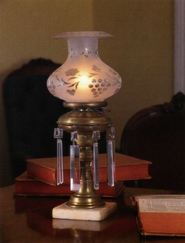 A brass astral lamp with a marble base and frosted, cut-glass baluster shade; patented July 14, 1849, New York City. (Photo courtesy Lee W. Rahe and Rickey Yanaura)
A brass astral lamp with a marble base and frosted, cut-glass baluster shade; patented July 14, 1849, New York City. (Photo courtesy Lee W. Rahe and Rickey Yanaura) We know from the probate inventories of Black Belt planters who died between 1845 and 1860 that most families in this region of the state had only one or two lamps per residence. Most would have been fueled by commercially made lard oil, which was produced by boiling pig fat. Not surprisingly, lard oil had a decidedly unpleasant odor and, like all oil lamps, it deposited a heavy layer of soot as it burned , necessitating the daily cleaning of lamp chimneys and shade. The best and cleanest-burning fuel available was whale oil, but it was expensive and rarely used, as was kerosene, which was not introduced in the South until the mid-1850s.
According to probate inventories, even in the best houses, some rooms were furnished with neither candlesticks nor lamps. Alexander Graham, who died in Eutaw in 1850, had a passage or hanging lamp in the parlor, two candlesticks and a lamp in the dining room, and twenty-eight spermaceti candles in the pantry, but no lighting forms of any kind in the five bedrooms. The home of Henry Watson, which was inventoried in 1866, when he sold the house, must have been the best-lit house in Greene County. He displayed a bronzed solar lamp, a set of bronzed girandoles in the parlor, a passage lamp in the hall, two brass candlesticks in the north front bedroom, a candle stand and lamp mat in another bedroom, no lighting in another bedroom, one lard lamp in the dining room, one lard lamp in the sitting room, no lighting in the library, a candle stand in a garret bedroom, and one lard lamp and four small lamps in the storeroom.
Less-affluent people, which included the vast majority of Black Belt residents, had no lighting forms at all, but they would have had alternative lighting sources that would not have been recorded in inventories. Some used pine splints or torches, or candles or oil without specialized holders, or fireplaces alone for light in the night.
Even in wealthy homes, room light was very low by today's standards, and those dim lights had an effect on antebellum tastes in furniture and fabrics. To understand the qualities antebellum planters valued in home furnishings, turn off the lights in your living or dining room and place one lighted candle in the room. Look at your room again through nineteenth-century eyes. Notice the interesting shadows created by wall and furniture moldings, how raised woven fabric designs stand out, and how the grain of polished wood glistens, creating delicate patterns of light and shadow. For affluent planters, how their furnishings looked after dark was as important, if not more important, as how they looked during the day. Sadly, in the brightly lit world of the late twentieth century, this is an aesthetic that has been lost.
This feature was previously published in Issue 46, Fall 1997.
Author
Lee W. Rahe is an authority on the decorative arts of the antebellum South.
 RSS Feed
RSS Feed